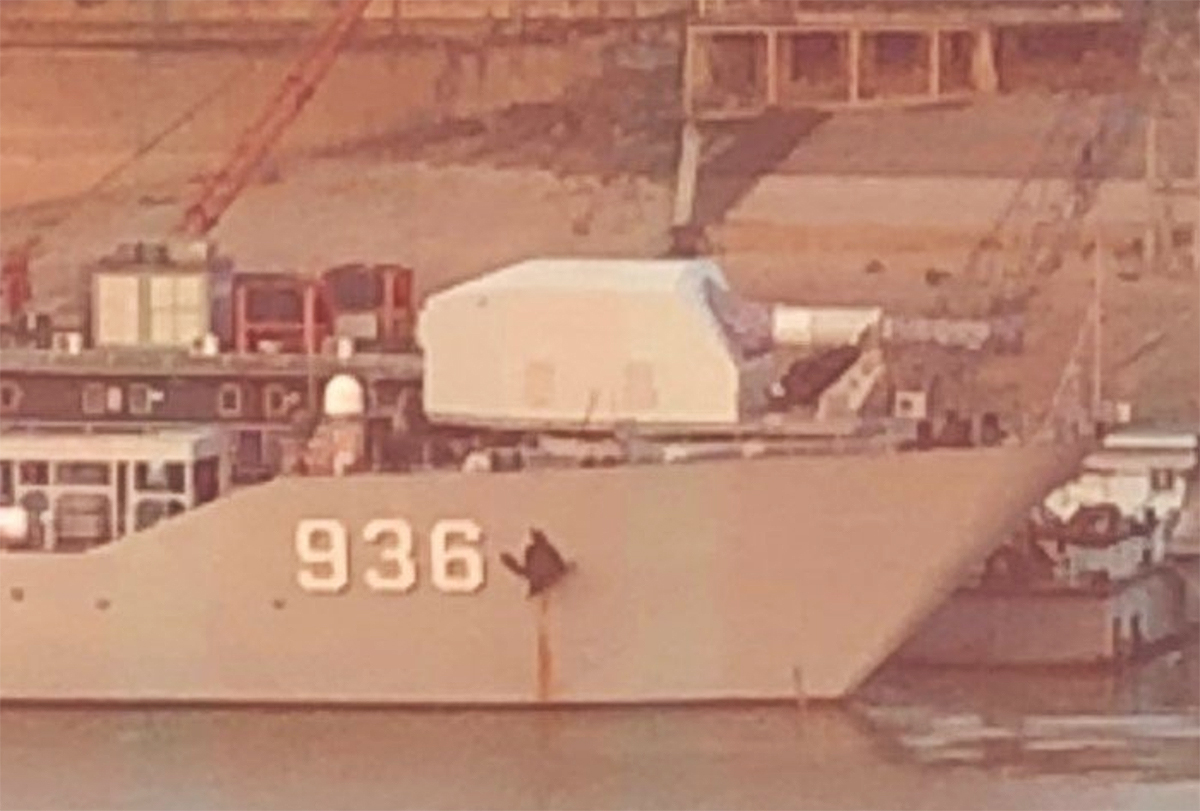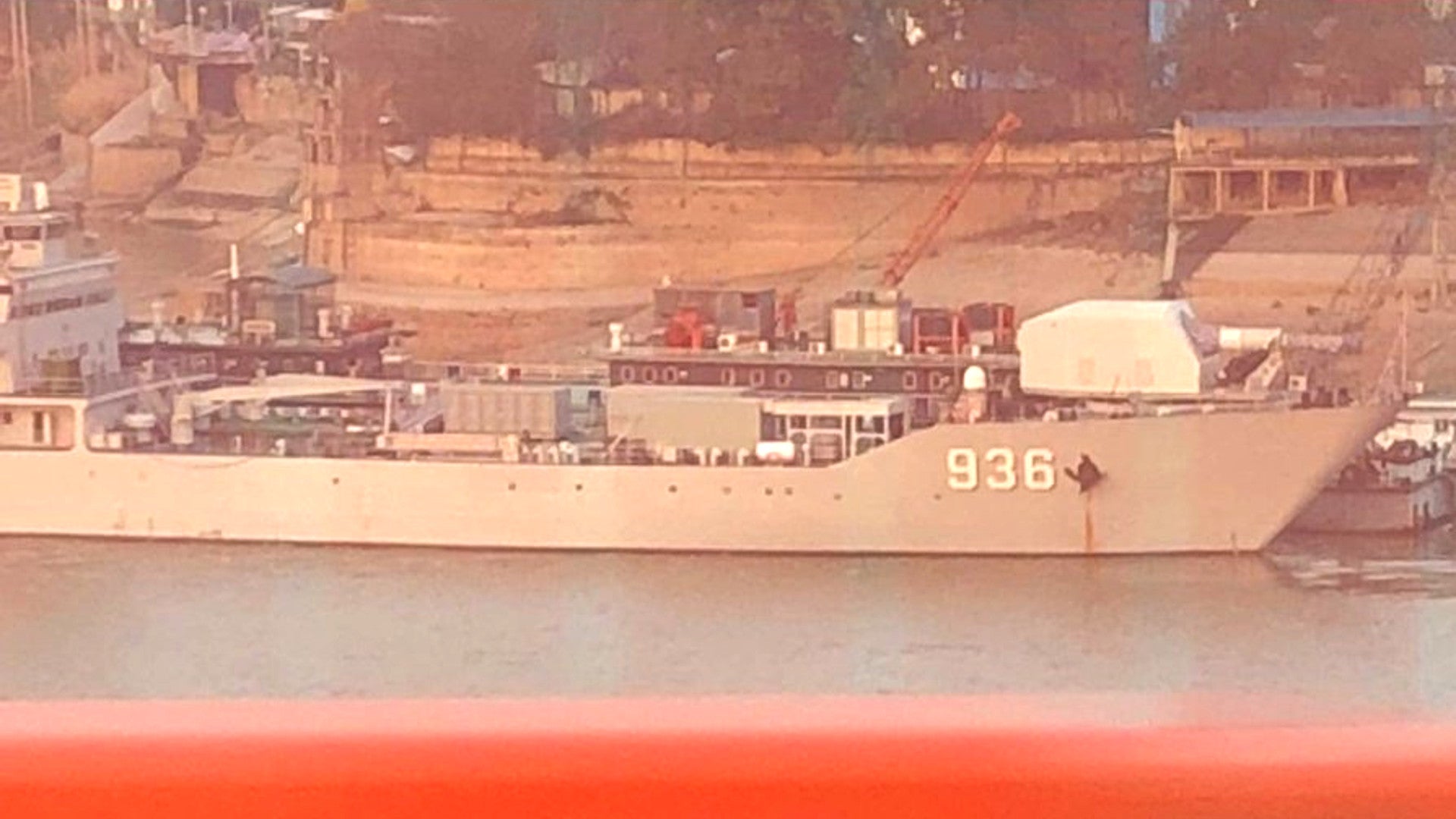Pictures have emerged on social media that show a Chinese landing ship armed with what could be a prototype railgun. If confirmed, this would be the first time any country has actually installed an electromagnetic gun system on a ship, even for test purposes, and would be a game-changing development for China’s military.
The images now circulating online show the People’s Liberation Army Navy’s (PLAN) Haiyang Shan, a Type 072III-class landing ship with the pennant number 936, sitting in Wuchang Shipyard in Hubei province with a new, massive gun turret fitted on its bow. The mount appears to be fully enclosed and features a large diameter gun barrel. The other vessels in the class have a significantly smaller twin 37mm cannon in that position.

There are also a number of shipping containers amidships, which could contain the large power source required for an electromagnetic weapon system. One of them also features an air conditioner, which could be to cool power generators or other electronic systems or be an indicator of a manned control station for the weapon or a place where engineers could sit and gather data during live fire experiments.
The cannon’s size and shape, as well as the nearby containers, are reminiscent of the U.S. Navy’s own prototype railgun. While that system has yet to go to sea, the service has released a number of images and video of the land-based test fixture showing the boxy-looking cannon on a frame with its power source and other control systems in containers below. It also features an automatic loading system.
With so much equipment exposed on the deck, the fit aboard the Haiyang Shan does not appear to be an operational design. Designed to carry up to 500 tons of cargo, the Type 072III-class does make good sense as a test ship, though.
The U.S. Navy has itself proposed using a Spearhead-class expeditionary fast transport, previously known as the Joint High Speed Vessel, for the first at-sea tests of its own prototype railgun. These vessels are based on catamaran ferry design and have a large, open helicopter landing pad that could accommodate temporary test article installations.
According to the U.S. Navy’s own public plans, they envision a weapon that would give ships significantly increased range over existing cannons, allows those vessels them to engage targets faster, and has the ability to hit enemy forces on land and at sea, as well as knock down aircraft, cruise missiles, and ballistic missiles. On top of that, it could make those ships less vulnerable and ease the strain on the logistics chain, since the ammunition is inert and doesn’t require an explosive charge to sending it flying down range. These features also mean the weapon could be cheaper than a traditional gun system and give ships more magazine depth by storing more rounds in the same space that propelling charges previously occupied. You can read more about these potential benefits here.
As such, the weapons could be useful for both a wide array of different mission sets, including sea control and amphibious operations, both of which are important considerations for China, which has vast maritime territorial claims. The PLAN is already in the midst of a major push to expand the size and capabilities of its surface fleets, as well.
The Chinese military has also been heavily invested in railguns and other related technologies, such as electromagnetic catapults to launch aircraft from its future aircraft carriers. China’s electromagnetic weapon research reportedly dates to at least the 1980s, but there were indications that it had advanced considerably just recently. In October 2017, Rear Admiral Ma Weiming, in charge of such research at the PLAN University of Engineering in Wuhan – the capital of Hubei province, home of Wuchang Shipyard – announced his team had made major breakthroughs in their research.
The gun aboard Haiyang Shan could also just be a large conventional cannon or a hybrid system of some type that combines a railgun’s inert, hypervelocity projectile design with a traditional chemical propelling charge. The U.S. Army and Navy have both looked at the latter concept as a way to leverage work on electromagnetic weapons and get at least some limited capabilities into combat in the near term.
The Navy’s experimental railgun shoots rounds at approximately six times the speed of sound. In theory, a conventional ship cannon or artillery piece could fire that same aerodynamic projectile at speeds up to Mach 3, which would be significantly faster than is possible with existing ammunition.
But the U.S. Navy has reportedly begun to lose interest in electromagnetic weapons after more than a decade of research and development without a prototype that meets the requirements for a field test. We at The War Zone have reached out to the Office of Naval Research, which is leading the effort, to try and confirm the status of the program, but have so far not received responses to our queries.

Its worth noting that Wuchang Shipyard has previously performed tests of major equipment destined for the advanced Type 055 destroyer and the country’s aircraft carriers, among other ships.
Suffice to say, Chinese warships equipped with electromagnetic guns, or even hybrid systems, could significantly help in the PLAN’s ability to project power and deny access to various parts Pacific region it claims as its integral national territory. This, in turn, would pose an all new challenge to its competitors in those spaces, especially the United States. But above all else, it is another very high-tech area where Beijing may be quickly moving past parity with the United States, a phenomenon that is becoming an increasingly dire concern within the halls of the Pentagon.
UPDATE: We have posted a followup article with a new high resolution picture linked here.
Contact the author: joe@thedrive.com
